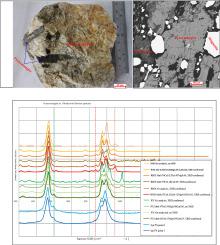Our official English website, www.x-mol.net, welcomes your feedback! (Note: you will need to create a separate account there.)
Geochemistry and mineralogy of the Jebel Aja Igneous Intrusion and the associated exotic pegmatites, Arabian Shield, Saudi Arabia
Lithos ( IF 3.5 ) Pub Date : 2021-07-26 , DOI: 10.1016/j.lithos.2021.106395 Hisham A. Gahlan 1, 2 , Paul D. Asimow 3 , Mokhles K. Azer 4 , Chi Ma 3 , Khaled M. Al-Kahtany 5 , Alaa Y. Hakeem 1
Lithos ( IF 3.5 ) Pub Date : 2021-07-26 , DOI: 10.1016/j.lithos.2021.106395 Hisham A. Gahlan 1, 2 , Paul D. Asimow 3 , Mokhles K. Azer 4 , Chi Ma 3 , Khaled M. Al-Kahtany 5 , Alaa Y. Hakeem 1
Affiliation

|
We describe the Jebel Aja igneous intrusion (JAII), which sits at the farthest northeastern edge of the exposed Arabian Shield in Saudi Arabia. The JAII consists of late Neoproterozoic post-collisional A-type granites, and was emplaced during tectonic extension. It is a composite pluton consisting of a granitic core (monzogranite, syenogranite and alkali feldspar granite) surrounded by a later phase of alkaline and peralkaline granites. Pegmatites occur as pockets and dykes at the contact between the alkaline/peralkaline granites and syenogranite. The pegmatites have sharp contacts with their host granites and show variable colors (principally pink and white), grain sizes, textures, and mineral compositions. We report here that the white pegmatites host pockets with a unique mineralogy that includes the first observation of pyroxmangite, thortveitite and thalénite-(Y) in the whole Arabian Shield as well as a novel (Sc, Y, vacancy)-rich pyroxenoid and a vacancy-rich bustamite with excess octahedral Si. The pyroxmangite-dominated lithology also features accessory quartz, albite, spessartine, pyrochroite, muscovite, and fluorite. The presence of pyroxmangite rather than rhodonite, together with vacancy-rich and Si-excess pyroxenes, suggests an elevated pressure of emplacement. The granites of the JAII are highly evolved and have undergone extreme fractional crystallization of feldspars, leading to increases in the concentration of volatile and incompatible elements in the residual melt, which resulted eventually in injection of coeval pegmatites into the mostly solidified host granite. The syenogranite and alkaline/peralkaline granite of the JAII contain sodic amphibole and have geochemical characteristics common among within-plate rare-metal bearing A-type rocks. They have positive Nb-Ta anomalies that increase from syenogranite to alkaline/peralkaline granite. The pink pegmatite is highly mineralized and contains high concentrations of Nb (1540–1769 μg/g), Ta (103–136 μg/g), Y (1116–1616 μg/g), Zr (6362–9707 μg/g), Hf (215–264 μg/g), Th (278–384 μg/g), U (110–147 μg/g), and ∑REE (2334–3251 μg/g).
中文翻译:

沙特阿拉伯阿拉伯地盾阿贾山火成岩和相关的奇异伟晶岩的地球化学和矿物学
我们描述了阿贾山火成岩侵入体 (JAII),它位于沙特阿拉伯暴露的阿拉伯地盾的最东北边缘。JAII 由新元古代晚期碰撞后 A 型花岗岩组成,在构造伸展过程中侵位。它是一种复合岩体,由花岗岩核心(二长花岗岩、正长花岗岩和碱长石花岗岩)组成,周围环绕着后期的碱性和过碱性花岗岩。伟晶岩以袋状和岩脉形式出现在碱性/过碱性花岗岩和正长花岗岩之间的接触处。伟晶岩与其母体花岗岩有尖锐的接触,并显示出不同的颜色(主要是粉红色和白色)、粒度、纹理和矿物成分。我们在这里报告,白色伟晶岩具有独特的矿物学特征,其中包括在整个阿拉伯地盾中首次观察到的辉石锰矿、硅锰矿和拉铅矿-(Y),以及一种富含 (Sc, Y, 空位) 的辉石类和具有过量八面体 Si 的富含空位的氟铜矿。以辉锰矿为主的岩性还含有副石英、钠长石、锰铝矿、火铬矿、白云母和萤石。辉石锰矿而不是蔷薇辉石的存在,以及富含空位和硅过量的辉石,表明侵位压力升高。JAII 的花岗岩高度演化,并经历了长石的极端分异结晶,导致残余熔体中挥发性和不相容元素的浓度增加,最终导致同时代伟晶岩注入大部分凝固的主花岗岩中。JAII的正长花岗岩和碱性/过碱性花岗岩含有钠质角闪石,具有板内含稀有金属A型岩石所共有的地球化学特征。它们具有从正长花岗岩到碱性/过碱性花岗岩的正 Nb-Ta 异常。粉红色伟晶岩高度矿化,含有高浓度的 Nb (1540–1769 μg/g)、Ta (103–136 μg/g)、Y (1116–1616 μg/g)、Zr (6362–9707 μg/g) 、Hf (215–264 μg/g)、Th (278–384 μg/g)、U (110–147 μg/g) 和 ΣREE (2334–3251 μg/g)。
更新日期:2021-07-26
中文翻译:

沙特阿拉伯阿拉伯地盾阿贾山火成岩和相关的奇异伟晶岩的地球化学和矿物学
我们描述了阿贾山火成岩侵入体 (JAII),它位于沙特阿拉伯暴露的阿拉伯地盾的最东北边缘。JAII 由新元古代晚期碰撞后 A 型花岗岩组成,在构造伸展过程中侵位。它是一种复合岩体,由花岗岩核心(二长花岗岩、正长花岗岩和碱长石花岗岩)组成,周围环绕着后期的碱性和过碱性花岗岩。伟晶岩以袋状和岩脉形式出现在碱性/过碱性花岗岩和正长花岗岩之间的接触处。伟晶岩与其母体花岗岩有尖锐的接触,并显示出不同的颜色(主要是粉红色和白色)、粒度、纹理和矿物成分。我们在这里报告,白色伟晶岩具有独特的矿物学特征,其中包括在整个阿拉伯地盾中首次观察到的辉石锰矿、硅锰矿和拉铅矿-(Y),以及一种富含 (Sc, Y, 空位) 的辉石类和具有过量八面体 Si 的富含空位的氟铜矿。以辉锰矿为主的岩性还含有副石英、钠长石、锰铝矿、火铬矿、白云母和萤石。辉石锰矿而不是蔷薇辉石的存在,以及富含空位和硅过量的辉石,表明侵位压力升高。JAII 的花岗岩高度演化,并经历了长石的极端分异结晶,导致残余熔体中挥发性和不相容元素的浓度增加,最终导致同时代伟晶岩注入大部分凝固的主花岗岩中。JAII的正长花岗岩和碱性/过碱性花岗岩含有钠质角闪石,具有板内含稀有金属A型岩石所共有的地球化学特征。它们具有从正长花岗岩到碱性/过碱性花岗岩的正 Nb-Ta 异常。粉红色伟晶岩高度矿化,含有高浓度的 Nb (1540–1769 μg/g)、Ta (103–136 μg/g)、Y (1116–1616 μg/g)、Zr (6362–9707 μg/g) 、Hf (215–264 μg/g)、Th (278–384 μg/g)、U (110–147 μg/g) 和 ΣREE (2334–3251 μg/g)。



























 京公网安备 11010802027423号
京公网安备 11010802027423号